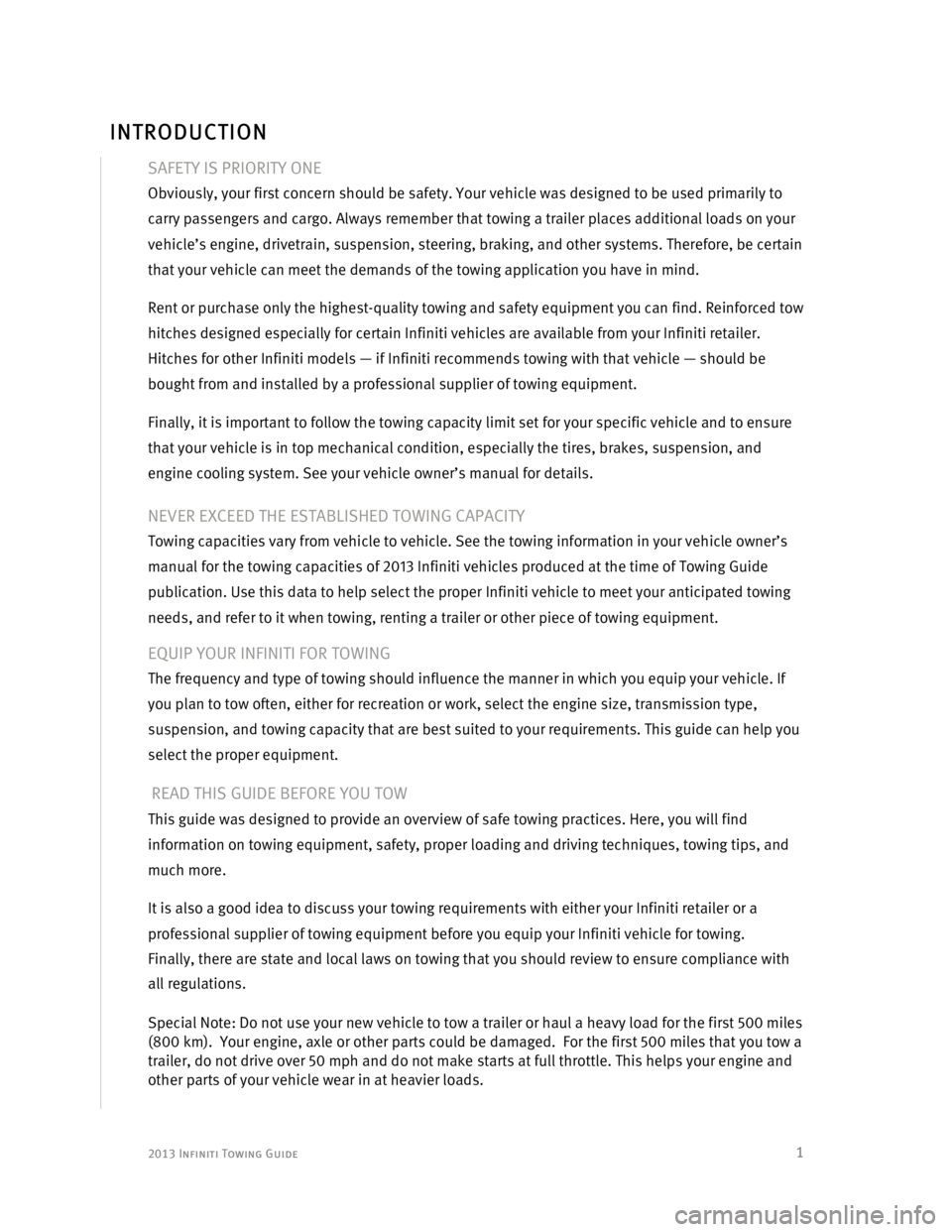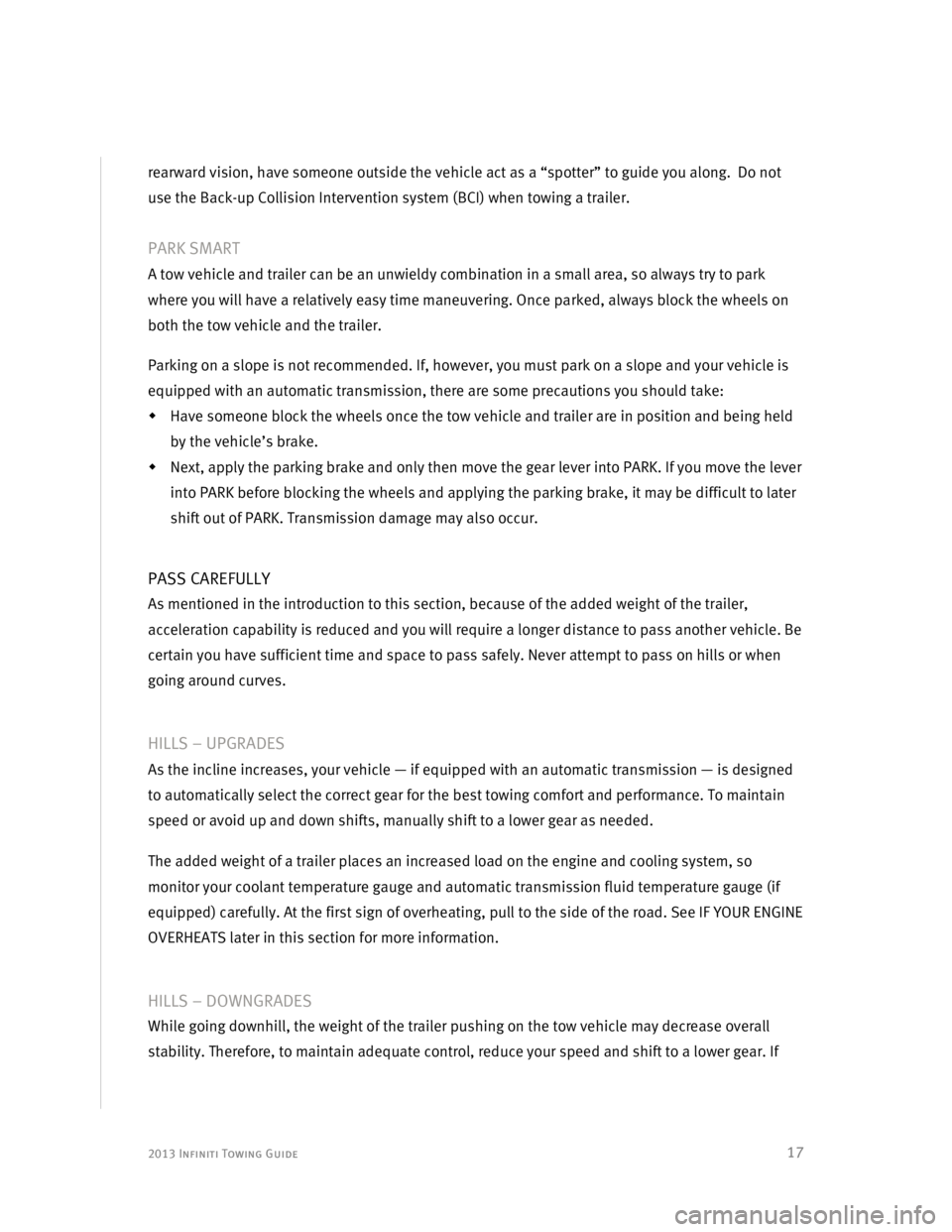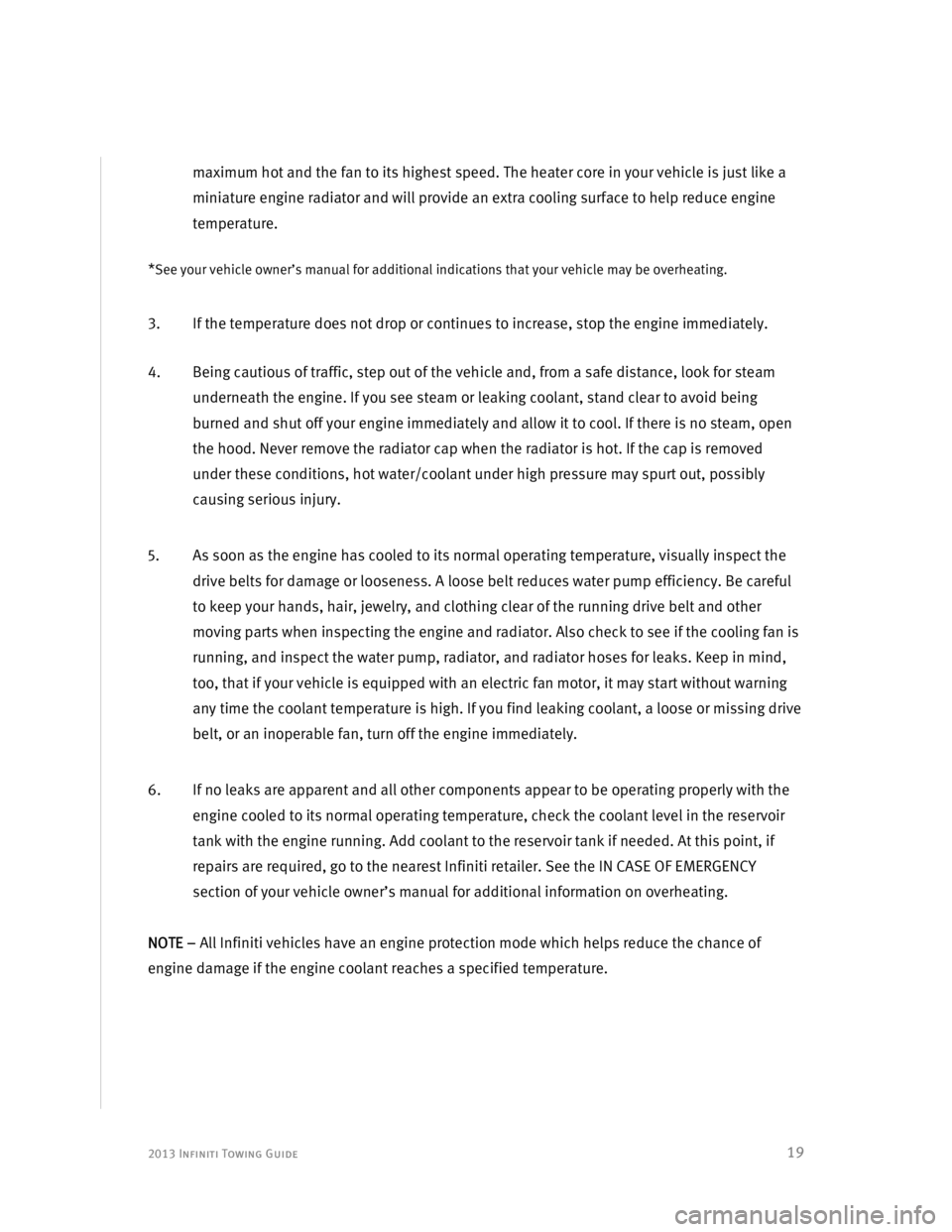cooling INFINITI EX 2013 Towing Guide
[x] Cancel search | Manufacturer: INFINITI, Model Year: 2013, Model line: EX, Model: INFINITI EX 2013Pages: 25, PDF Size: 0.42 MB
Page 2 of 25

2013 Infiniti Towing Guide
1
SAFETY IS PRIORITY ONE
Obviously, your first concern should be safety. Your vehicle was designed to be used primarily to
carry passengers and cargo. Always remember that towing a trailer places additional loads on your
vehicle’s engine, drivetrain, suspension, steering, braking, and other systems. Therefore, be certain
that your vehicle can meet the demands of the towing application you have in mind.
Rent or purchase only the highest-quality towing and safety equipment you can find. Reinforced tow
hitches designed especially for certain Infiniti vehicles are available from your Infiniti retailer.
Hitches for other Infiniti models — if Infiniti recommends towing with that vehicle — should be
bought from and installed by a professional supplier of towing equipment.
Finally, it is important to follow the towing capacity limit set for your specific vehicle and to ensure
that your vehicle is in top mechanical condition, especially the tires, brakes, suspension, and
engine cooling system. See your vehicle owner’s manual for details.
NEVER EXCEED THE ESTABLISHED TOWING CAPACITY
Towing capacities vary from vehicle to vehicle. See the towing information in your vehicle owner’s
manual for the towing capacities of 2013 Infiniti vehicles produced at the time of Towing Guide
publication. Use this data to help select the proper Infiniti vehicle to meet your anticipated towing
needs, and refer to it when towing, renting a trailer or other piece of towing equipment.
EQUIP YOUR INFINITI FOR TOWING
The frequency and type of towing should influence the manner in which you equip your vehicle. If
you plan to tow often, either for recreation or work, select the engine size, transmission type,
suspension, and towing capacity that are best suited to your requirements. This guide can help you
select the proper equipment.
READ THIS GUIDE BEFORE YOU TOW
This guide was designed to provide an overview of safe towing practices. Here, you will find
information on towing equipment, safety, proper loading and driving techniques, towing tips, and
much more.
It is also a good idea to discuss your towing requirements with either your Infiniti retailer or a
professional supplier of towing equipment before you equip your Infiniti vehicle for towing.
Finally, there are state and local laws on towing that you should review to ensure compliance with
all regulations.
Special Note: Do not use your new vehicle to tow a trailer or haul a heavy load for the first 500 miles
(800 km). Your engine, axle or other parts could be damaged. For the first 500 miles that you tow a
trailer, do not drive over 50 mph and do not make starts at full throttle. This helps your engine and
other parts of your vehicle wear in at heavier loads.
INTRODUCTION
Page 18 of 25

2013 Infiniti Towing Guide
17
rearward vision, have someone outside the vehicle act as a “spotter” to guide you along. Do not
use the Back-up Collision Intervention system (BCI) when towing a trailer.
PARK SMART
A tow vehicle and trailer can be an unwieldy combination in a small area, so always try to park
where you will have a relatively easy time maneuvering. Once parked, always block the wheels on
both the tow vehicle and the trailer.
Parking on a slope is not recommended. If, however, you must park on a slope and your vehicle is
equipped with an automatic transmission, there are some precautions you should take:
�Š Have someone block the wheels once the tow vehicle and trailer are in position and being held
by the vehicle’s brake.
�Š Next, apply the parking brake and only then move the gear lever into PARK. If you move the lever
into PARK before blocking the wheels and applying the parking brake, it may be difficult to later
shift out of PARK. Transmission damage may also occur.
PASS CAREFULLY
As mentioned in the introduction to this section, because of the added weight of the trailer,
acceleration capability is reduced and you will require a longer distance to pass another vehicle. Be
certain you have sufficient time and space to pass safely. Never attempt to pass on hills or when
going around curves.
HILLS – UPGRADES
As the incline increases, your vehicle — if equipped with an automatic transmission — is designed
to automatically select the correct gear for the best towing comfort and performance. To maintain
speed or avoid up and down shifts, manually shift to a lower gear as needed.
The added weight of a trailer places an increased load on the engine and cooling system, so
monitor your coolant temperature gauge and automatic transmission fluid temperature gauge (if
equipped) carefully. At the first sign of overheating, pull to the side of the road. See IF YOUR ENGINE
OVERHEATS later in this section for more information.
HILLS – DOWNGRADES
While going downhill, the weight of the trailer pushing on the tow vehicle may decrease overall
stability. Therefore, to maintain adequate control, reduce your speed and shift to a lower gear. If
Page 20 of 25

2013 Infiniti Towing Guide
19
maximum hot and the fan to its highest speed. The heater core in your vehicle is just like a
miniature engine radiator and will provide an extra cooling surface to help reduce engine
temperature.
*
See your vehicle owner’s manual for additional indications that your vehicle may be overheating.
3. If the temperature does not drop or continues to increase, stop the engine immediately.
4. Being cautious of traffic, step out of the vehicle and, from a safe distance, look for steam
underneath the engine. If you see steam or leaking coolant, stand clear to avoid being
burned and shut off your engine immediately and allow it to cool. If there is no steam, open
the hood. Never remove the radiator cap when the radiator is hot. If the cap is removed
under these conditions, hot water/coolant under high pressure may spurt out, possibly
causing serious injury.
5. As soon as the engine has cooled to its normal operating temperature, visually inspect the
drive belts for damage or looseness. A loose belt reduces water pump efficiency. Be careful
to keep your hands, hair, jewelry, and clothing clear of the running drive belt and other
moving parts when inspecting the engine and radiator. Also check to see if the cooling fan is
running, and inspect the water pump, radiator, and radiator hoses for leaks. Keep in mind,
too, that if your vehicle is equipped with an electric fan motor, it may start without warning
any time the coolant temperature is high. If you find leaking coolant, a loose or missing drive
belt, or an inoperable fan, turn off the engine immediately.
6. If no leaks are apparent and all other components appear to be operating properly with the
engine cooled to its normal operating temperature, check the coolant level in the reservoir
tank with the engine running. Add coolant to the reservoir tank if needed. At this point, if
repairs are required, go to the nearest Infiniti retailer. See the IN CASE OF EMERGENCY
section of your vehicle owner’s manual for additional information on overheating.
NOTE – All Infiniti vehicles have an engine protection mode which helps reduce the chance of
engine damage if the engine coolant reaches a specified temperature.